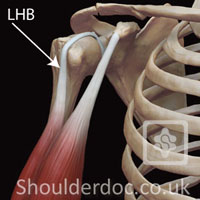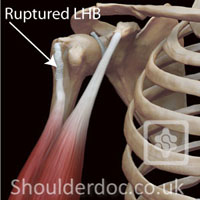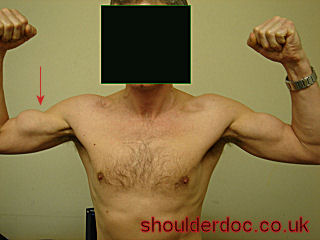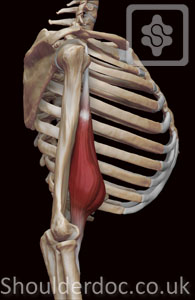LHB Tendon Rupture
The biceps may rupture at the top of the bicipital groove in the shoulder (long head of biceps - LHB) or at the biceps tuberosity in the elbow. Click here for bicep ruptures at the elbow.
 The Long Head of Biceps (LHB) tendon is an important tendon for walking in four-legged animals, but in humans it has very little function or strength. It may have a small role in shoulder stability when all the other tendons are gone, but it does not contribute any strength to the biceps muscle itself.
The Long Head of Biceps (LHB) tendon is an important tendon for walking in four-legged animals, but in humans it has very little function or strength. It may have a small role in shoulder stability when all the other tendons are gone, but it does not contribute any strength to the biceps muscle itself.
It is a common cause of pain with shoulder injuries and diseases as it has a lot of nerve cells. It can degenetate and inflame (tendonitis). A diseased LHB can also rupture.
There is often a relief of chronic shoulder pain when the tendon ruptures, since the partially torn tendon is often the main cause of pain (see biceps tendonitis). This rupture is equivalent to a natural tenotomy. When the bicep injury occurs, pain is instant and you might hear a "pop" sound. Bicep injury bruising will follow soon after. This results in a 'popeye' deformity and weakness of the biceps.
Surgery is very rarely needed for a LHB tendon rupture, as most people and function perfectly well, without any loss of strength or pain. A bulging 'popeye' bicep might be visible in leaner people, but does not cause any functional loss.
Very rarely a small proportion of people may have long-term issues and then a biceps tenodesis is an option - but this is not to improve the appearance or cosmesis.

Ruptured right LHB with Popeye sign biceps (arrow)



